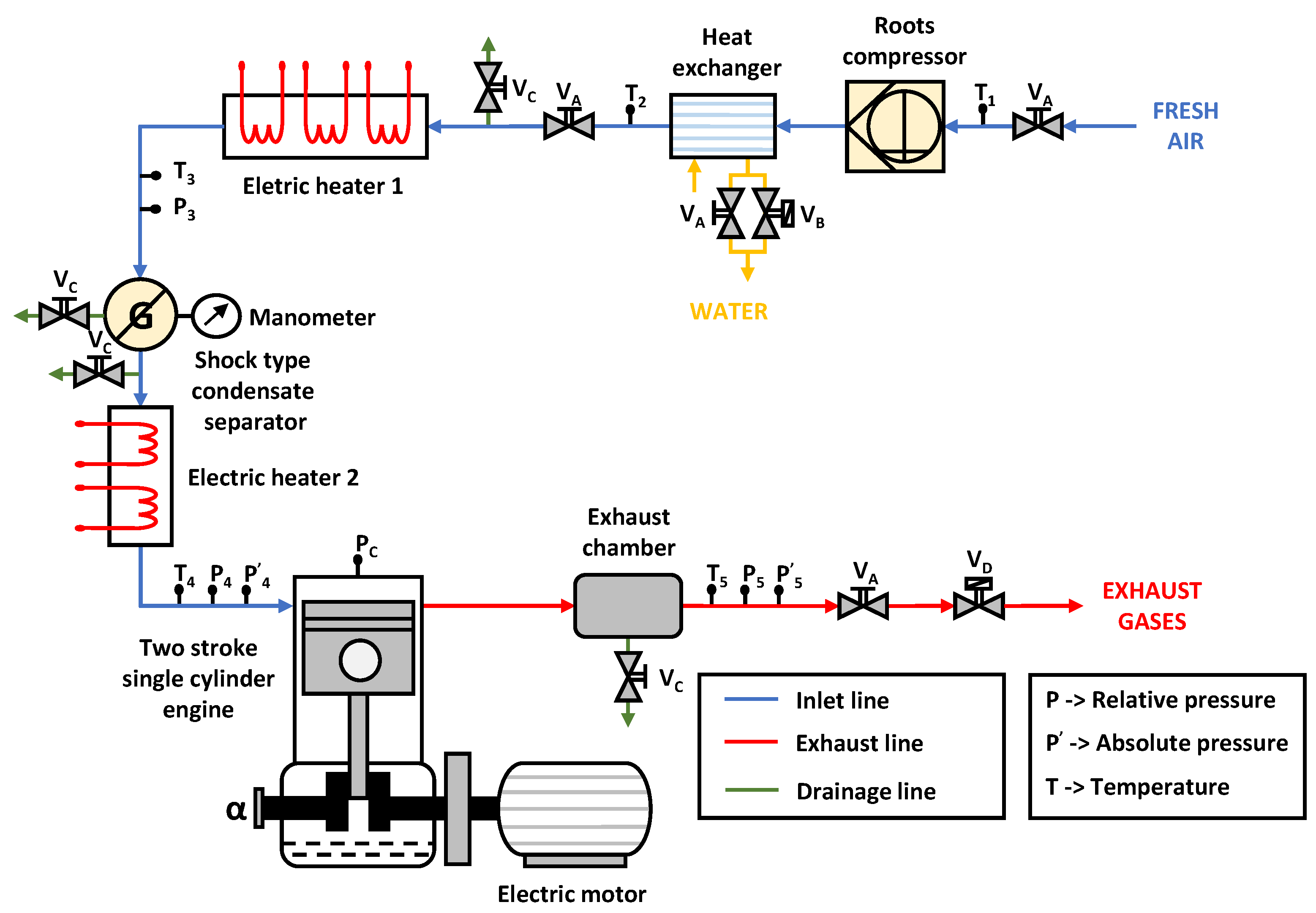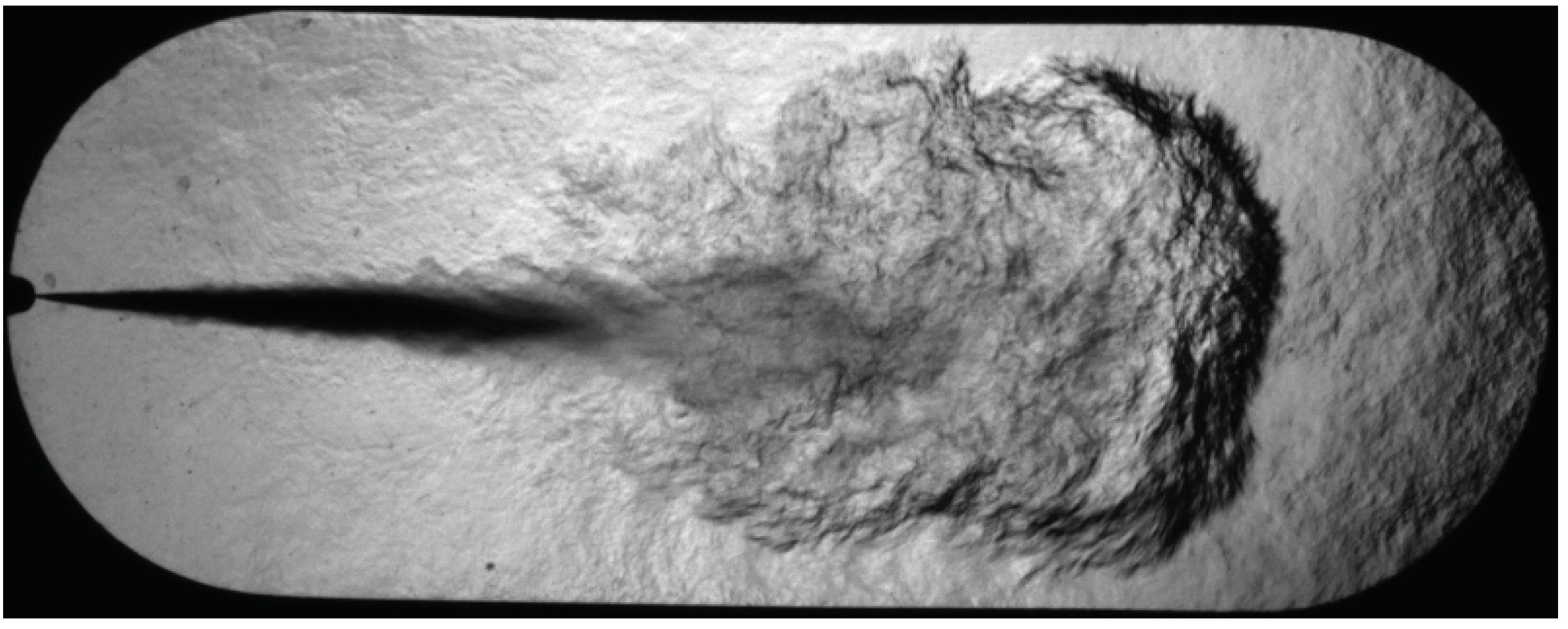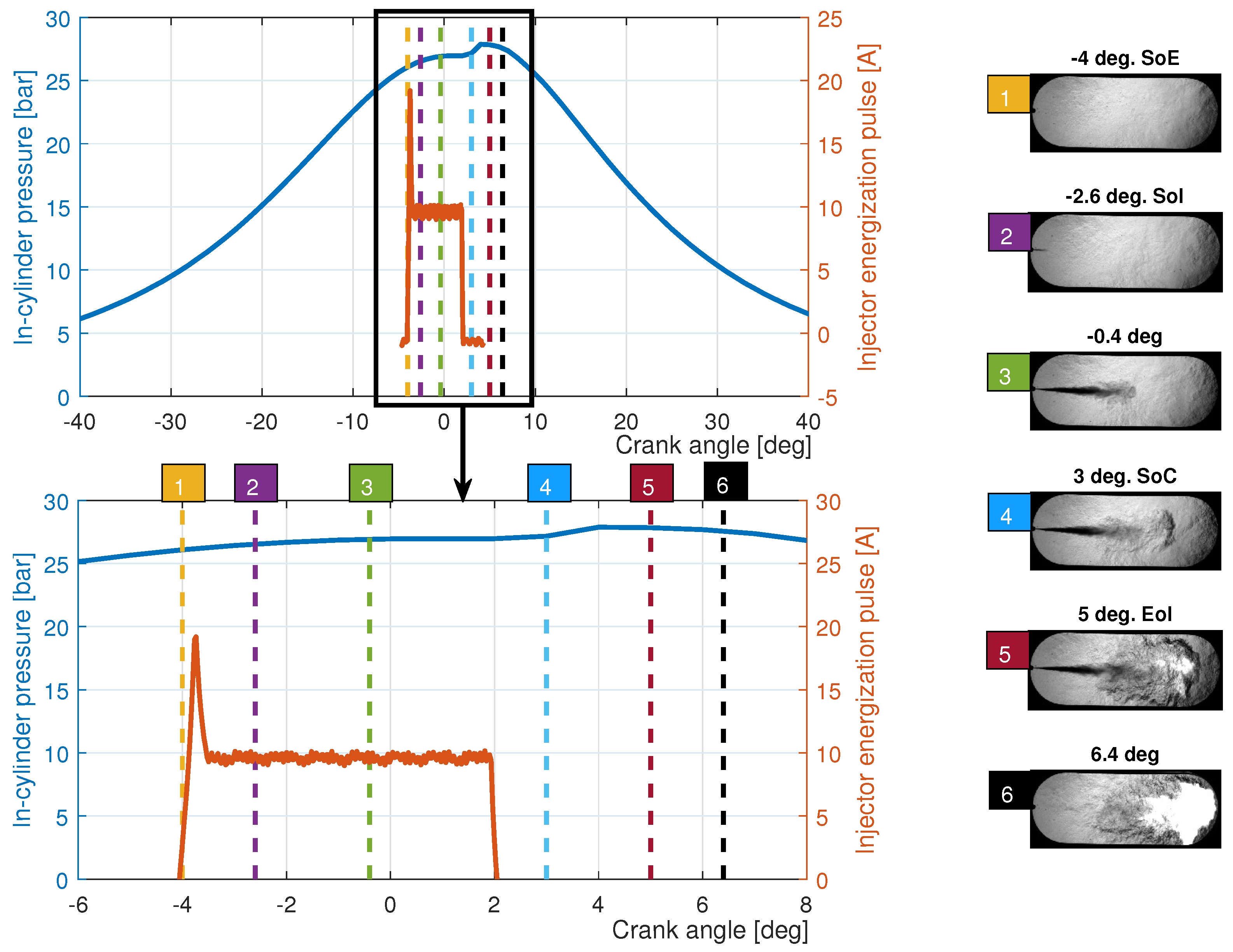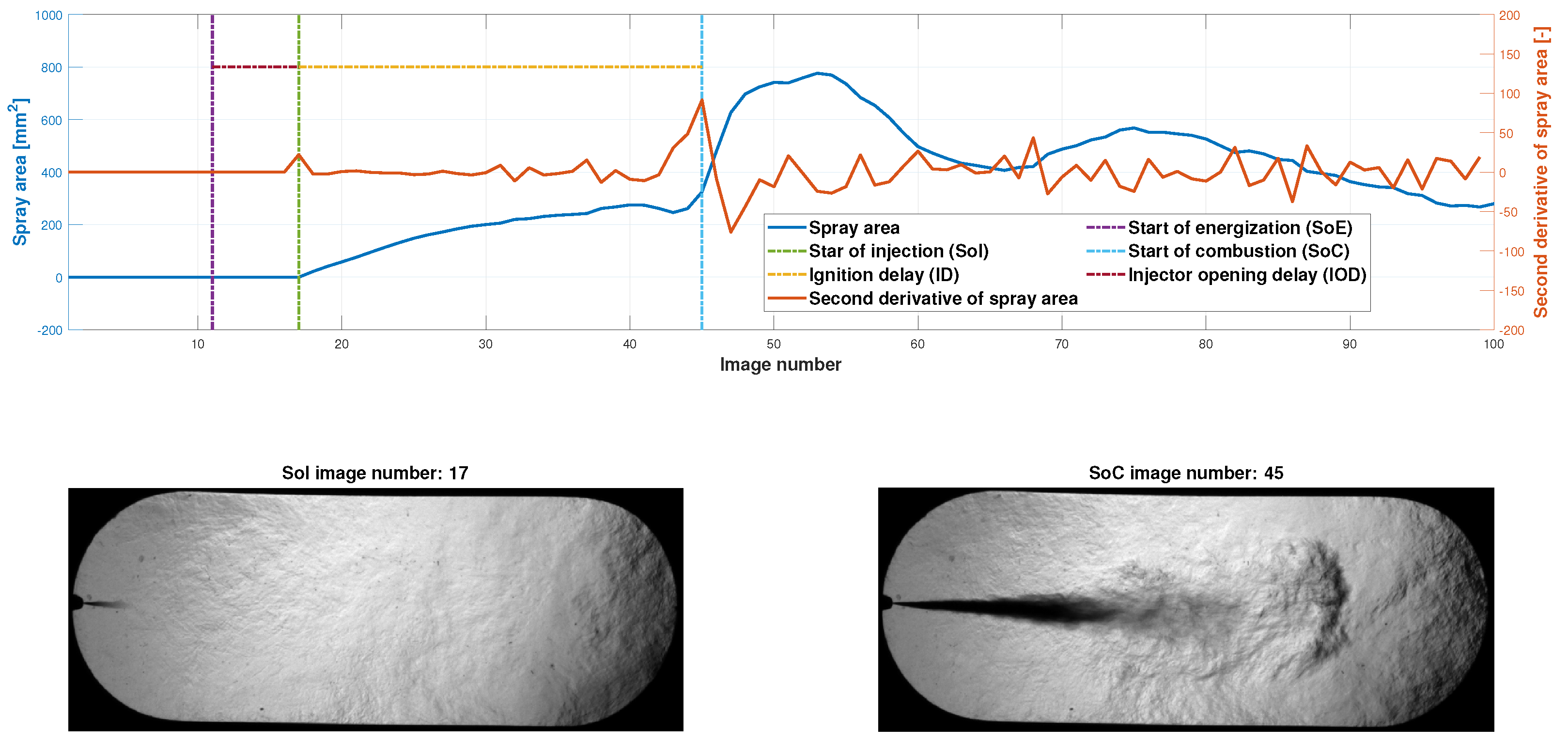Macroscopic Parameters of Fuel Sprays Injected in an Optical Reciprocating Single-Cylinder Engine: An Approximation by Means of Visualization with Schlieren Technique
Abstract
1. Introduction
2. Materials and Methods
2.1. Experimental Facility
2.2. Visualization System
2.3. Image-Processing Algorithm
2.3.1. Image Preprocessing
2.3.2. Spray Macroscopic Parameters Calculation
2.3.3. Spray Surface and Volume Calculation
2.3.4. Injector Opening Delay and Ignition Delay
3. Results and Discussion
4. Conclusions
Author Contributions
Funding
Institutional Review Board Statement
Informed Consent Statement
Data Availability Statement
Acknowledgments
Conflicts of Interest
References
- Ulloa, C.; Nuñez, J.M.; Lin, C.; Rey, G. AHP-based design method of a lightweight, portable and flexible air-based PV-T module for UAV shelter hangars. Renew. Energy 2018, 123, 767–780. [Google Scholar] [CrossRef]
- Bachmann, R. Biologically inspired mechanisms facilitating multimodal locomotion for areal micro-robot. In Proceedings of the 24th International Unmanned Air Vehicles Conference, Bristol, UK, 30 March–1 April 2009. [Google Scholar]
- Pan, Z.; An, L.; Wen, C. Recent advances in fuel cells based propulsion systems for unmanned aerial vehicles. Appl. Energy 2019, 240, 473–485. [Google Scholar] [CrossRef]
- Çoban, S.; Oktay, T. Unmanned aerial vehicles (UAVs) according to engine type. J. Aviat. 2018, 2, 177–184. [Google Scholar] [CrossRef]
- Li, J.; Zhou, L.; Zhao, Z.; Wang, X.; Zhang, F. Research on knocking characteristics of kerosene spark-ignition engine for unmanned aerial vehicle (UAV) by numerical simulation. Therm. Sci. Eng. Prog. 2019, 9, 1–10. [Google Scholar] [CrossRef]
- Dudek, M.; Tomczyk, P.; Wygonik, P.; Korkosz, M.; Bogusz, P.; Lis, B. Hybrid fuel cell–battery system as a main power unit for small unmanned aerial vehicles (UAV). Int. J. Electrochem. Sci. 2013, 8, 8442–8463. [Google Scholar] [CrossRef]
- Cames, M.; Helmers, E. Critical evaluation of the European diesel car boom-global comparison, environmental effects and various national strategies. Environ. Sci. Eur. 2013, 25, 15. [Google Scholar] [CrossRef]
- Korres, D.M.; Karonis, D.; Lois, E.; Linck, M.B.; Gupta, A.K. Aviation fuel JP-5 and biodiesel on a diesel engine. Fuel 2008, 87, 70–78. [Google Scholar] [CrossRef]
- Wadud, Z. Diesel demand in the road freight sector in the UK: Estimates for different vehicle types. Appl. Energy 2016, 165, 849–857. [Google Scholar] [CrossRef]
- Anderson, J.O.; Thundiyil, J.G.; Stolbach, A. Clearing the air: A review of the effects of particulate matter air pollution on human health. J. Med. Toxicol. 2012, 8, 166–175. [Google Scholar] [CrossRef]
- Harada, A.; Shimazaki, N.; Sasaki, S.; Miyamoto, T.; Akagawa, H.; Tsujimura, K. The Effects of Mixture Formation on Premixed Lean Diesel Combustion Engine; Technical Report, SAE Technical Paper; SAE: Warrendale, PA, USA, 1998. [Google Scholar]
- Akihama, K.; Takatori, Y.; Inagaki, K.; Sasaki, S.; Dean, A.M. Mechanism of the smokeless rich diesel combustion by reducing temperature. Sae Trans. 2001, 110, 648–662. [Google Scholar]
- Kim, H.J.; Park, S.H.; Lee, C.S. Impact of fuel spray angles and injection timing on the combustion and emission characteristics of a high-speed diesel engine. Energy 2016, 107, 572–579. [Google Scholar] [CrossRef]
- Lahane, S.; Subramanian, K. Effect of different percentages of biodiesel–diesel blends on injection, spray, combustion, performance, and emission characteristics of a diesel engine. Fuel 2015, 139, 537–545. [Google Scholar] [CrossRef]
- Lee, S.; Lee, C.S.; Park, S.; Gupta, J.G.; Maurya, R.K.; Agarwal, A.K. Spray characteristics, engine performance and emissions analysis for Karanja biodiesel and its blends. Energy 2017, 119, 138–151. [Google Scholar] [CrossRef]
- Bermúdez, V.; García, J.; Juliá, E.; Martínez, S. Engine with Optically Accessible Cylinder Head: A Research Tool for Injection and Combustion Processes; Technical Report, SAE Technical Paper; SAE: Warrendale, PA, USA, 2003. [Google Scholar]
- Corral-Gómez, L.; Armas, O.; Soriano, J.A.; Pastor, J.V.; García-Oliver, J.M.; Micó, C. An Optical Engine Used as a Physical Model for Studies of the Combustion Process Applying a Two-Color Pyrometry Technique. Energies 2022, 15, 4717. [Google Scholar] [CrossRef]
- Pastor, J.; Payri, R.; Gimeno, J.; Nerva, J. Experimental study on RME blends: Liquid-phase fuel penetration, chemiluminescence, and soot luminosity in diesel-like conditions. Energy Fuels 2009, 23, 5899–5915. [Google Scholar] [CrossRef]
- Skeen, S.A.; Manin, J.; Pickett, L.M. Simultaneous formaldehyde PLIF and high-speed schlieren imaging for ignition visualization in high-pressure spray flames. Proc. Combust. Inst. 2015, 35, 3167–3174. [Google Scholar] [CrossRef]
- Li, F.; Lee, C.F.; Wang, Z.; Wu, H.; Lu, G. Schlieren investigation on impacts of duct size on macroscopic spray characteristics of ducted fuel injection. Appl. Therm. Eng. 2020, 176, 115440. [Google Scholar] [CrossRef]
- Benajes, J.; Payri, R.; Bardi, M.; Martí-Aldaraví, P. Experimental characterization of diesel ignition and lift-off length using a single-hole ECN injector. Appl. Therm. Eng. 2013, 58, 554–563. [Google Scholar] [CrossRef]
- Bardi, M.; Payri, R.; Malbec, L.M.C.; Bruneaux, G.; Pickett, L.M.; Manin, J.; Bazyn, T.; Genzale, C.L. Engine combustion network: Comparison of spray development, vaporization, and combustion in different combustion vessels. At. Sprays 2012, 22, 807–842. [Google Scholar] [CrossRef]
- Park, S.W.; Reitz, R.D. Optimization of fuel/air mixture formation for stoichiometric diesel combustion using a 2-spray-angle group-hole nozzle. Fuel 2009, 88, 843–852. [Google Scholar] [CrossRef]
- Doppalapudi, A.T.; Azad, A.; Khan, M. Combustion chamber modifications to improve diesel engine performance and reduce emissions: A review. Renew. Sustain. Energy Rev. 2021, 152, 111683. [Google Scholar] [CrossRef]
- Settles, G.S. Schlieren and Shadowgraph Techniques: Visualizing Phenomena in Transparent Media; Springer Science and Business Media: London, UK, 2001. [Google Scholar]
- Nerva, J.G. An Assessment of Fuel Physical and Chemical Properties in the Combustion of a Diesel Spray. Ph.D. Thesis, Universitat Politècnica de València, Valencia, Spain, 2013. [Google Scholar]
- Briceño Sánchez, F.J. Aportaciones al Estudio de la Evolución Transitoria de Llamas de Difusión Diesel. Ph.D. Thesis, Universitat Politècnica de València, Valencia, Spain, 2016. [Google Scholar]
- Micó Reche, C. Development of Measurement and Visualization Techniques for Characterization of Mixing and Combustion Processes with Surrogate Fuels. Ph.D. Thesis, Universitat Politècnica de València, Valencia, Spain, 2015. [Google Scholar]
- Xuan, T. Optical Investigations on Diesel Spray Dynamics and In-Flame Soot Formation. Ph.D. Thesis, Universitat Politècnica de València, Valencia, Spain, 2018. [Google Scholar]
- Pastor, J.V.; Arregle, J.; Palomares, A. Diesel spray image segmentation with a likelihood ratio test. Appl. Opt. 2001, 40, 2876–2885. [Google Scholar] [CrossRef]
- Rubio-Gómez, G.; Martínez-Martínez, S.; Rua-Mojica, L.F.; Gómez-Gordo, P.; De la Garza, O.A. Automatic macroscopic characterization of diesel sprays by means of a new image processing algorithm. Meas. Sci. Technol. 2018, 29, 055406. [Google Scholar] [CrossRef]
- Corral-Gómez, L.; Rubio-Gómez, G.; Martínez-Martínez, S.; Sánchez-Cruz, F. Effect of diesel-biodiesel-ethanol blends on the spray macroscopic parameters in a common-rail diesel injection system. Fuel 2019, 241, 876–883. [Google Scholar] [CrossRef]
- Reichenbach, S.E.; Ni, M.; Zhang, D.; Ledford, E.B., Jr. Image background removal in comprehensive two-dimensional gas chromatography. J. Chromatogr. A 2003, 985, 47–56. [Google Scholar] [CrossRef] [PubMed]
- Chaki, N.; Shaikh, S.H.; Saeed, K.; Chaki, N.; Shaikh, S.H.; Saeed, K. A Comprehensive Survey on Image Binarization Techniques; Springer: Berlin/Heidelberg, Germany, 2014. [Google Scholar]
- Otsu, N. A threshold selection method from gray-level histograms. IEEE Trans. Syst. Man Cybern. 1979, 9, 62–66. [Google Scholar] [CrossRef]
- Maire, M.R. Contour Detection and Image Segmentation; University of California: Berkeley, CA, USA, 2009. [Google Scholar]
- Piccardi, M. Background subtraction techniques: A review. In Proceedings of the 2004 IEEE International Conference on Systems, Man and Cybernetics (IEEE Cat. No. 04CH37583), The Hague, The Netherlands, 10–13 October 2004; IEEE: Piscataway, NJ, USA, 2004; Volume 4, pp. 3099–3104. [Google Scholar]
- Tian, J.; Liu, Y.; Bi, H.; Li, F.; Bao, L.; Han, K.; Zhou, W.; Ni, Z.; Lin, Q. Experimental study on the spray characteristics of octanol diesel and prediction of spray tip penetration by ANN model. Energy 2022, 239, 121920. [Google Scholar] [CrossRef]
- Gonzalez, R.C.; Woods, R.E.; Eddins, S.L. Digital Image Processing Using MATLAB; Pearson: London, UK, 2004. [Google Scholar]
- Shao, J.; Yan, Y.; Greeves, G.; Smith, S. Quantitative characterization of diesel sprays using digital imaging techniques. Meas. Sci. Technol. 2003, 14, 1110. [Google Scholar] [CrossRef]
- Wang, X.; Huang, Z.; Kuti, O.A.; Zhang, W.; Nishida, K. Experimental and analytical study on biodiesel and diesel spray characteristics under ultra-high injection pressure. Int. J. Heat Fluid Flow 2010, 31, 659–666. [Google Scholar] [CrossRef]
- Payri, R.; Gimeno, J.; Bracho, G.; Vaquerizo, D. Study of liquid and vapor phase behavior on Diesel sprays for heavy duty engine nozzles. Appl. Therm. Eng. 2016, 107, 365–378. [Google Scholar] [CrossRef]
- Armas, O.; Martínez-Martínez, S.; Mata, C.; Pacheco, C. Alternative method for bulk modulus estimation of Diesel fuels. Fuel 2016, 167, 199–207. [Google Scholar] [CrossRef]
- Pickett, L.M.; Kook, S.; Williams, T.C. Visualization of diesel spray penetration, cool-flame, ignition, high-temperature combustion, and soot formation using high-speed imaging. SAE Int. J. Engines 2009, 2, 439–459. [Google Scholar] [CrossRef]
- Payri, R.; Salvador, F.; Manin, J.; Viera, A. Diesel ignition delay and lift-off length through different methodologies using a multi-hole injector. Appl. Energy 2016, 162, 541–550. [Google Scholar] [CrossRef]
- Han, D.; Zhai, J.; Duan, Y.; Ju, D.; Lin, H.; Huang, Z. Macroscopic and microscopic spray characteristics of fatty acid esters on a common rail injection system. Fuel 2017, 203, 370–379. [Google Scholar] [CrossRef]
- Park, S.H.; Kim, S.H.; Lee, C.S. Mixing stability and spray behavior characteristics of diesel- ethanol- methyl ester blended fuels in a common-rail diesel injection system. Energy Fuels 2009, 23, 5228–5235. [Google Scholar] [CrossRef]
- Han, S.; Kim, J.; Bae, C. Effect of air-fuel mixing quality on characteristics of conventional and low temperature diesel combustion. Appl. Energy 2014, 119, 454–466. [Google Scholar]
- Ra, Y.; Reitz, R.D.; Mcfarlane, J.; Daw, C.S. Effects of fuel physical properties on diesel engine combustion using diesel and bio-diesel fuels. SAE Int. J. Fuels Lubr. 2009, 1, 703–718. [Google Scholar] [CrossRef]
- Agarwal, A.K.; Srivastava, D.K.; Dhar, A.; Maurya, R.K.; Shukla, P.C.; Singh, A.P. Effect of fuel injection timing and pressure on combustion, emissions and performance characteristics of a single cylinder diesel engine. Fuel 2013, 111, 374–383. [Google Scholar] [CrossRef]

















| Properties | Value | Units |
|---|---|---|
| Lens type | Nikon 105 mm F2.8 Macro IF-ED AF-S | - |
| Dynamic range | 12 | bits |
| Acquisition speed | 800,000 (128 × 16 pixels) | fps |
| Exhibition time | 1 to 0.002 | ms |
| Image resolution | 1024 × 1024 | pixels |
| Memory | 8 | GB |
| Parameters | Value | Units |
|---|---|---|
| Injection pressure | 50, 70, 90, 110 | MPa |
| Energization time | 2 | ms |
| Fuel temperature | 313 | K |
| Intake pressure | 0.13 | MPa |
| Intake temperature | 323 | K |
| Properties | Diesel |
|---|---|
| C (% w/w) | 86.2 |
| H (% w/w) | 13.8 |
| O (% w/w) | 0 |
| Density at 15 °C (kg/m) | 835.8 |
| Density at 40 °C (kg/m) | 827.6 |
| Viscosity at 40 °C (cSt) | 2.96 |
| CFPP (°C) | −19 |
| Flash point (°C) | 61 |
| Cetane number | 54.5 |
| HHV (MJ/Kg) | 45.97 |
| LHV (MJ/Kg) | 43.18 |
| Distillation (vol.) | |
| 10% (°C) | 206.5 |
| 50% (°C) | 275.9 |
| 90% (°C) | 344.9 |
Disclaimer/Publisher’s Note: The statements, opinions and data contained in all publications are solely those of the individual author(s) and contributor(s) and not of MDPI and/or the editor(s). MDPI and/or the editor(s) disclaim responsibility for any injury to people or property resulting from any ideas, methods, instructions or products referred to in the content. |
© 2023 by the authors. Licensee MDPI, Basel, Switzerland. This article is an open access article distributed under the terms and conditions of the Creative Commons Attribution (CC BY) license (https://creativecommons.org/licenses/by/4.0/).
Share and Cite
Corral-Gómez, L.; Castillo-García, F.J.; Soriano, J.A.; Armas, O. Macroscopic Parameters of Fuel Sprays Injected in an Optical Reciprocating Single-Cylinder Engine: An Approximation by Means of Visualization with Schlieren Technique. Sensors 2023, 23, 6747. https://doi.org/10.3390/s23156747
Corral-Gómez L, Castillo-García FJ, Soriano JA, Armas O. Macroscopic Parameters of Fuel Sprays Injected in an Optical Reciprocating Single-Cylinder Engine: An Approximation by Means of Visualization with Schlieren Technique. Sensors. 2023; 23(15):6747. https://doi.org/10.3390/s23156747
Chicago/Turabian StyleCorral-Gómez, Lis, Fernando J. Castillo-García, José A. Soriano, and Octavio Armas. 2023. "Macroscopic Parameters of Fuel Sprays Injected in an Optical Reciprocating Single-Cylinder Engine: An Approximation by Means of Visualization with Schlieren Technique" Sensors 23, no. 15: 6747. https://doi.org/10.3390/s23156747
APA StyleCorral-Gómez, L., Castillo-García, F. J., Soriano, J. A., & Armas, O. (2023). Macroscopic Parameters of Fuel Sprays Injected in an Optical Reciprocating Single-Cylinder Engine: An Approximation by Means of Visualization with Schlieren Technique. Sensors, 23(15), 6747. https://doi.org/10.3390/s23156747









